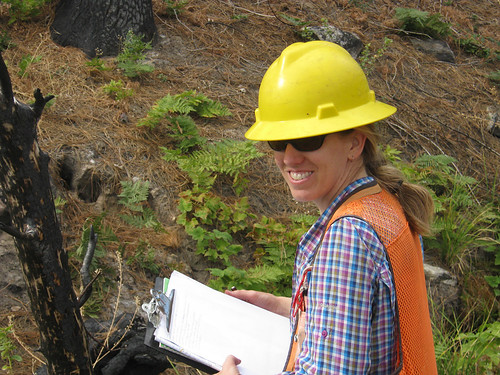
Watching the golden glow of the sun alight upon meadow grasses stirs my imagination. My mind conjures up misty visions of the famous naturalist, John Muir, traipsing through the Sierras, admiring Corn Lilies and sedges. A red-tailed hawk swoops into this vision and silently plucks a pocket gopher with outstretched talons. Coursing through this living landscape, creating a back drop for this scene, is the magical, musical sound of water.
Aside from their beauty, meadows provide a variety of important ecological functions. A multitude of species depend upon riparian areas and meadows to survive. Black bears turn over meadow logs looking for ants. Deer nibble the grasses and brush. Coyote music echoes across the flatlands and bounces between walls of lava stone. Walk close to the waterway of a meadow and you may hear the plop of a basking frog as it jumps the bank to enter the stream of life.
Hydrologically speaking, meadows are an important part of the water flow not only for wildlife and rare plants like moonwarts, but for us. When meadows are endangered the repercussions affect us all. Fifty percent of the surface water in California flows from National Forest lands and meadows help to hold and purify that water.
“Meadows help filter flood waters, trapping sediment and other pollutants,” said Zachary Croyle, a hydrologist who works on the Calaveras District of the Stanislaus National Forest. “That action improves water quality and makes the water flowing downstream from our mountain meadows relatively clean.”
Meadows also act like large sponges. They slowly absorb and release water. That sponge-like quality allows meadows to store water and release it steadily, over time.
“In a post-fire environment healthy meadows can lessen the threat of flooding and reduce downstream sedimentation problems,” said Mary Moore, Stanislaus National Forest hydrologist. “That’s one reason we have assessed more than 40 meadows and are committed to restoring 25 of these meadows found within the perimeter of the Rim Fire.”
Watersheds that have been impacted by fire take seven to ten years to heal. It may take months or years for plants to recolonize burned sites and the ground cover to be restored. In the interim, heavy rain storms can pick up ash and bare soil particles, sweeping them into waterways.
“That increases sedimentation problems down-stream,” said Moore.
In the past five years, large wildfires have cost municipal water users over $300 million dollars due to filtration and sedimentation problems.
It does not, however, take a large wildland fire to drive home the importance of meadows or restoring the landscape.
Being good land stewards is an everyday project that we all need to embrace. The worth of our Forests is not only in the value of our timber, nor strictly in the water we provide, but is in the health and resiliency of the landscapes and watersheds we love, and depend on.
“Caring for the land now, helps all of us down the road,” said Croyle. “Ecological restoration is happening within the footprint of the Rim Fire but the Cornerstone Collaborative Forest Landscape Restoration Project is also aimed at restoring these critical features elsewhere on the Forest because of their vast importance.”
As the climate changes in the Sierras, scientists expect less winter snow to fall in the mountains. The snow pack acts as a reservoir, releasing water as it melts throughout the spring and early summer.
If snow gets replaced by rain, water flow would rapidly decline during the dry season when it is needed the most. A well-functioning meadow can capture and slow down the fleeting flow of water, making it more available in the drier months of the year.
Keeping meadows in good shape is not as easy as you might think for they can be harmed in a variety of ways. Stressors such as livestock grazing, road development and unauthorized off-highway vehicle use can negatively impact meadows. Native plant communities may shift as a result and that can contribute to soil erosion and the loss of water availability. Gullies and deep channel cuts can change water flow patterns detrimentally and even conifers can encroach upon meadows when normal fire cycles are missed or when droughts persist.
In a rapidly changing world, it’s comforting to know that the true value and joy of a meadow can be found in coyote songs and meadow flowers. It can also be found in the tall glass of pure drinking water you press to your lips on a hot day. John Muir once said, “When we try to pick out anything by itself, we find it hitched to everything else in the universe.” The story of meadows and water is no exception. This story winds its way through forest, sedge and Corn Lily. It touches the life of the bear and hawk and travels many mountainous miles to our very own drinking tap.
